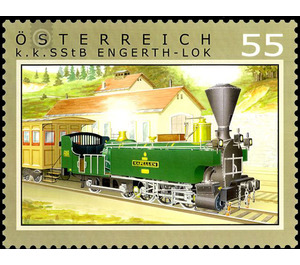railroad - Austria / II. Republic of Austria 2004 - 55 Euro Cent
Theme: Traffic, Transportation & Mobility
| Country | Austria / II. Republic of Austria |
| Issue Date | 2004 |
| Face Value | 55.00 |
| Edition Issued | 600,000 |
| Printing Type | combination printing |
| Stamp Type | Commemorative |
| Item Type | Stamp |
| Chronological Issue Number | 1830 |
| Chronological Chapter | OOS-OE2 |
| SID | 919823 |
| In 69 Wishlists | |
On 17 July 2004, it is 150 years since the planned railway operation was taken over the Semmering. Despite a report by experts, which said that the only possibility for a railway on the Semmering by cable operation (funicular) is made, set Karl Ritter Ghega in 1848, the construction of a adhesion railway through - although there were not even at this time even locomotives that could handle such gradients (2.5%). Three years later, the first comparison runs with four specially designed for the mountain service on the Semmering steam locomotives were carried out. Each of the four prototypes outperformed the performance demanded in the tender "to pull 140 tons at 11.38 kilometers per hour on the biggest climb", but none was able to convince for a regular operation on Semmering. Only Wilhelm Freiherr von Engerth finally succeeded in constructing a series locomotive that was really suitable for mountain service. With it he wrote the first large chapter in the Austrian steam locomotive history. Between November 1853 and May 1854, 16 Engerth locomotives were delivered to the state railway. The triple-coupled support transmitter locomotives (type C2'n2t) brought it up to 19 km / h, even down to 23.The building and the unencumbered operation of the world's first real mountain railway made Austria at the forefront of technical progress in the railway industry for some time ,


